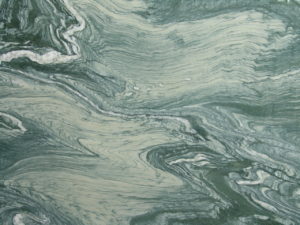Fixing Stains On Marble Part 2

You took the plunge and made the not insubstantial investment in adding marble to your renovation or remodeling project. In a previous blog, we discussed the proper care of your new marble, but what do you do in the event of a stain?
Here is what you need to know if that beautiful marble, installed as part of your kitchen renovation, bathroom remodeling or whole house project, gets stained.
Stain identification tips
Identifying the type of stain on the stone surface is the key to removing it. Stains can be oil-based, organic, metallic, biological, ink-based, paint-based or acid-based. If you don’t know what caused the stain, consider likely staining agents that may have been present.
Here are some questions you should consider:
- Where is the stain located?
- Is it near a plant, a food service area or an area where cosmetics are used?
- What color is it?
- What is the shape or pattern?
- What occurs in the area around the stain?
Stain removal steps
Surface stains canoften be removed by cleaning with an appropriate cleaning product or household chemical.
What type of stain is it?
The following sections describe the types of stains you may have to deal with and the appropriate household chemicals to use and how to prepare and apply a poultice to remove the stain.
Oil-based (Grease, plumbers’ putty, tar, cooking oil, milk, cosmetics)
An oil-based stain will darken the stone and normally must be chemically dissolved so the source of the stain can be flushed or rinsed away. Clean gently with a soft, liquid cleanser with one of the following: household detergent, mineral spirits, or acetone.
Organic (Coffee, tea, wine, fruit, tobacco, paper, food, urine, leaves, bark, bird droppings)
May cause a pinkish-brown stain and may disappear after the source of the stain has been removed. Outdoors, with the sources removed, sun and rain action will generally bleach out the stains. Indoors, clean with 12% hydrogen peroxide (hair bleaching strength) and a few drops of ammonia.
Metal (Iron, rust, copper, bronze)
Iron or rust stains are orange to brown in color and follow the shape of the staining object such as nails, bolts, screws, cans, flower pots, metal furniture. Copper and bronze stains appear as green or muddy-brown and result from the action of moisture on nearby or embedded bronze, copper or brass items. Metal stains must be removed with a poultice. (See website on Using a Poultice – http://www.marble-institute.com/consumers/poultices/ Deep-.seated, rusty stains are extremely difficult to remove and the stone may be permanently stained.
Biological (Algae, mildew, lichens, moss, fungi)
Clean with diluted cleaning solution. Use a 1/2 cup of any of the following: ammonia, bleach, or hydrogen peroxide and a gallon of water. Reminder: do not mix bleach and ammonia.
Ink (Magic marker, pen, ink)
On light colored stones, clean with bleach or hydrogen peroxide. On dark colored stones, clean with lacquer thinner or acetone.
Paint
Small amounts can be removed with lacquer thinner or scraped off carefully with a razor blade. Heavy paint coverage should be removed only with a commercial “heavy liquid” paint stripper, available from hardware stores and paint centers. These strippers normally contain caustic soda or lye. Do not use acids or flame tools to strip paint from stone. Paint strippers can etch the surface of the stone; resurfacing may be necessary. Follow the manufacturer’s directions for use of these products, and flush the area thoroughly with clean water. Protect yourself with rubber gloves and eye protection, and work in a well-ventilated area. Use only wood or plastic scrapers for removing the sludge and curdled paint. Normally, latex and acrylic paints will not cause staining. Oil-based paints, linseed oil, putty, caulks and sealants may cause oily stains. Refer to the section on oil-based stains.
Water Spots and Rings (Surface accumulation of hard water)
Buff with dry steel wool.
Fire and Smoke Damage
Older stones and smoke or fire-stained fireplaces may require a thorough cleaning. When the smoke is removed, there may also be some etching (due to carbonic & other acids in smoke). Commercially available “smoke removers” may save time and effort.
Etch Marks (Caused by acids left on the surface of the stone)
Some materials will etch the finish, but not leave a stain. Others will both etch and stain. Contact your stone dealer or call a professional stone restorer for refinishing or repolishing etched areas.
Efflorescence (A white powder that may appear on the surface of the stone)
It is caused by the deposition of mineral salts carried by water from below the surface of the stone. When the water evaporates, it leaves the powdery substance. If the installation is new, dust mop or vacuum the powder. You may have to do this several times as the stone dries out. Do not use water to remove the powder; it will only temporarily disappear. If the problem persists, contact your installer to help identify and remove the cause of the moisture.
Scratches and Nicks
Slight surface scratches may be buffed with dry 0000 steel wool. Deeper scratches and nicks in the surface of the stone should be repaired and repolished by a professional.
Using a Poultice
Go to http://www.marble-institute.com/consumers/poultices/ for more information, or call a stone professional (recommended).
What if you can’t get rid of the stain?
Call your professional stone supplier, installer or a restoration specialist for problems that appear too difficult to handle.
If you want to discuss adding marble or natural stone as part of your home renovation or bathroom or kitchen remodeling, Cornerstone Builders of Southwest Florida will come to your home for a free estimate. Please contact us today.

